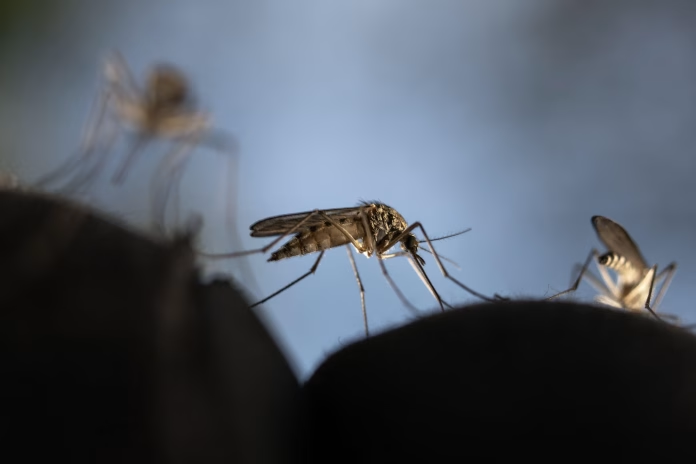By Johnson Siamachira
Harare, (New Ziana) – As the sun sets over the lush landscapes of Zimbabwe, the air thickens with humidity and the unmistakable buzz of mosquitoes, amid reports that this year the country faces a resurgent enemy, malaria, which threatens to undo years of progress in public health.
Health authorities report that, as of mid-September this year, Zimbabwe has recorded nearly 140 000 malaria cases and 376 deaths, a stark increase that has placed vulnerable populations, especially children under five, pregnant women, and the elderly, at heightened risk.
Malaria has always been endemic in Zimbabwe, but the current surge marks a troubling turning point which experts have described as “alarming,” “Prolonged rains have created ideal conditions for mosquito breeding, while socio-economic factors exacerbate the crisis,” says Dr Memory Mapfumo, an epidemiologist at the Africa Centres for Disease Control and Prevention.
Several factors have converged to create a perfect storm for malaria resurgence including La Niña-induced rains which have drenched regions like Mashonaland Central and Mashonaland East, leading to increased mosquito breeding sites while the incidence rate in Mashonaland West Province, for example, surged nearly fivefold from 2024 to 2025, rising from 1.54 to 7.66 per 1 000 people.
In addition, inadequate vector control measures, including gaps in indoor residual spraying (IRS) and limited access to insecticide-treated nets (ITNs), have left communities exposed. Professor Sungano Mharakurwa, director of Africa University’s Malaria Institute, says the funding cuts from the United States early this year have crippled vital programs, leaving the country vulnerable when it should be strengthening its defences.
“The Zento mosquito surveillance program was showing promising results before the funding cuts. Now, we are witnessing a rebound of cases that we had managed to suppress,” he explained.
The ZENTO program (Zimbabwe Entomological Support Program in Malaria) is a project at the Africa University in Manicaland province, a few kilometers outside Mutare, focused on malaria research and entomological surveillance to help eradicate the disease.
Dr Mharakurwa said since the Zento mosquito surveillance program began in Manicaland province, there had been a marked reduction in malaria cases and it was about to be extended when the US cuts came.
Africa University data shows that Manicaland recorded 145 775 malaria cases in 2020 but just 28 387 after Zento was introduced in 2021 and had been further reduced to 8 035 by 2024, before more than trebling to 27 212 the following year, when US funding was cut.
“The malaria was back with a vengeance straight after, and the number of cases that were waning rebounded in 2025, surpassing levels that had never been seen since the beginning of the project,” Dr Mharakurwa said.
Socio-economic challenges further complicate the situation as poorly maintained infrastructure and water shortages create ideal breeding grounds for mosquitoes and in rural areas, where access to healthcare is limited, patients often delay seeking treatment until it’s too late.
Early treatment is crucial. If we fail to provide timely interventions, we risk escalating the crisis,” said Dr Henry Madzorera, a former Health Minister. The surge in cases has placed immense pressure on healthcare facilities, particularly in rural communities where resources are already stretched thin with clinics facing increased patient loads, leading to shortages of medical supplies and staff fatigue.
Despite the grim outlook, Zimbabwe remains committed to its goal of malaria elimination by 2030 with the National Malaria Control Program focusing on vector control measures, community engagement, and adherence to World Health Organization guidelines for case management.
Cross-border collaborations with neighbouring countries aim to bolster surveillance and control efforts. However, experts warn that without sustained funding and community awareness, these strategies may falter.
“Governments must prioritise health funding domestically. Without a strong commitment to health, we risk losing the gains made over the last two decades,” says Itai Rusike, director of the Community Working Group on Health. Zimbabwe is not alone in its battle against malaria as neighbouring countries like Botswana and eSwatini are also grappling with rising cases, a reflection of broader trends across southern Africa.
According to the Africa CDC, the entire region is experiencing a resurgence, with climatic changes and human activities such as mining and agriculture, exposing more individuals to malaria. “As climate change accelerates, we face a growing threat from malaria-carrying mosquitoes.
This is not just a local issue; it requires coordinated international efforts to mitigate,” warns Dr Merawi Aragaw, head of the Africa CDC Surveillance and Disease Intelligence. As Zimbabwe confronts the resurgent malaria crisis, the urgency for immediate action cannot be overstated as the convergence of environmental, socio-economic, and funding challenges creates a complex landscape that demands innovative solutions.
While the fight against malaria remains an uphill battle, the commitment of health authorities and communities, coupled with renewed investment, offers a glimmer of hope. With the rainy season approaching, it is time for decisive action and Zimbabwe’s goal of malaria elimination by 2030 stands as a sign of resilience.
As Prof Mharakurwa aptly states, “If we can mobilise the right resources and community support, we can turn the tide against this deadly scourge.”
New Ziana



